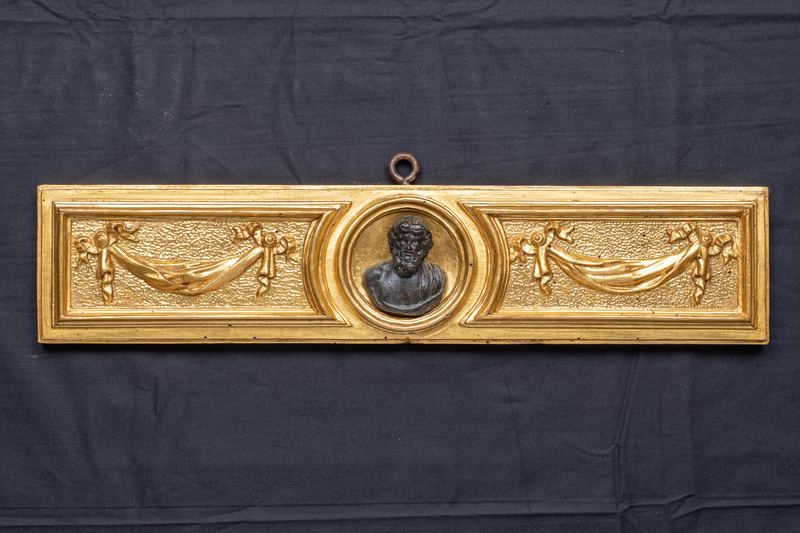Bust of a Bearded Male Figure
This small bust in patinated bronze portrays a male figure wearing a mantle called a himation over his chest and left shoulder. His thick hair is arranged in two locks parted in the middle over his forehead and comes down to join with his lush beard. His eyes are white and have spaces for inserting the pupils, which would probably have been made of a different material.
In the eighteenth century, the figurine was attached to a gilt frame embellished with festoons inside a circular niche by the goldsmith Luigi Valadier. The bronze is part of a group of similar figurines of varying subject kept in the storerooms of the Palazzina Borghese. Recent research has confirmed the authenticity of the sculpture, which would have been a refined decorative element and is datable to the middle of the second century CE.
Object details
Inventory
Location
Date
Classification
Medium
Dimensions
Provenance
Borghese Collection, documented in 1773. Purchased by the Italian State, 1902.
Exhibitions
- 2019 - Roma, Galleria Borghese
Conservation and Diagnostic
- 1773 , Luigi Valadier, restoration and fill
Commentary
This small bust portrays a bearded male figure. His torso is covered by a mantle called a himation, which is draped over the left shoulder and then twisted to stretch horizontally across the chest, up to the right shoulder. His head is turned slightly to the right and his thick hair is arranged in big, loose curls, with two big locks parted in the middle over the forehead. On the nape of his neck the rendering is compact, sticking close to the skull and described with a chisel. The beard is equally voluminous and comes down to the chest in wavy locks. The figure’s expression is serious and absorbed, with slightly furrowed brows. He has deep-set eyes, a straight nose and a small, partially open mouth with thin lips. There are holes in the eyes for inserting pupils, which would have been made of a different material.
The figure shares similarities with the iconographic type Jove the Thunderer, the archetype of which was the Zeus Brontaios a bronze sculpture attributed to the sculptor Leochares, who was active in Greece in the fourth century BCE. The sculpture was probably made in 371 BCE, for the founding of the city of Megalopolis in the Peloponnese and later brought to Rome during the reign of Emperor Augustus, as described by Pliny the Elder, who writes about it as Iuppiter Tonans (Pliny, Naturalis Historia 34.79; Arias 1961, pp. 565–6). The Borghese bust, which is very close to a similar one that was found in the Mill of Silvanus in Ostia Antica and is now in the Museo Ostiense (Calza, Squarciapino 1962, p. 102), is a miniature votive representation of a divinity that was probably made for decorative use.
The small bust, which is kept in the storerooms of the Palazzina Borghese, is part of a group of miniature bronzes of various subject that is not found in the inventories or bibliography relative to the archaeological collection. In 2019, Minozzi published a receipt, dated 1773 and discovered by Gonzàlez-Palacios, for work done by the goldsmith Luigi Valadier on various small bronzes described as ‘alcune figurine accomodate’ (‘a few repaired figurines’), among which she identified the present group (1993, pp. 37, 50). The receipt describes filling in missing parts and attaching the figurines to gilt wooden panels of various shape, which the author attributes to Valadier as well (2019, pp. 192–195). The small bust is set in a circular niche in a frame decorated with festoons. EDXRF analysis of the figure for the exhibition Valadier. Splendore nella Roma del Settecento, held in 2019 at the Galleria Borghese, cast doubt on its authenticity. The highly refined workmanship, elegant incision of the pupils and attention to detail suggest a date for the work in the middle of the second century CE.
Giulia Ciccarello
Bibliography
- P. E. Arias, s.v. Leochares 1, in “Enciclopedia dell’Arte Antica” IV, Roma 1961, pp. 565-6.
- R. Calza, M. Floriani Squarciapino, Museo Ostiense, Roma, 1962, p. 102.
- A. Gonzàlez-Palacios, Il gusto dei principi. Arte di corte del XVII e del XVIII secolo, Milano 1993.
- M. Minozzi, Cornici con applicazioni di bronzetti antichi e moderni, in Valadier. Splendore nella Roma del Settecento, catalogo della mostra (a cura di G. Leardi), Roma 2019, pp. 192-195.
- Schede di catalogo 12/99000473, G. Ciccarello 2020.


